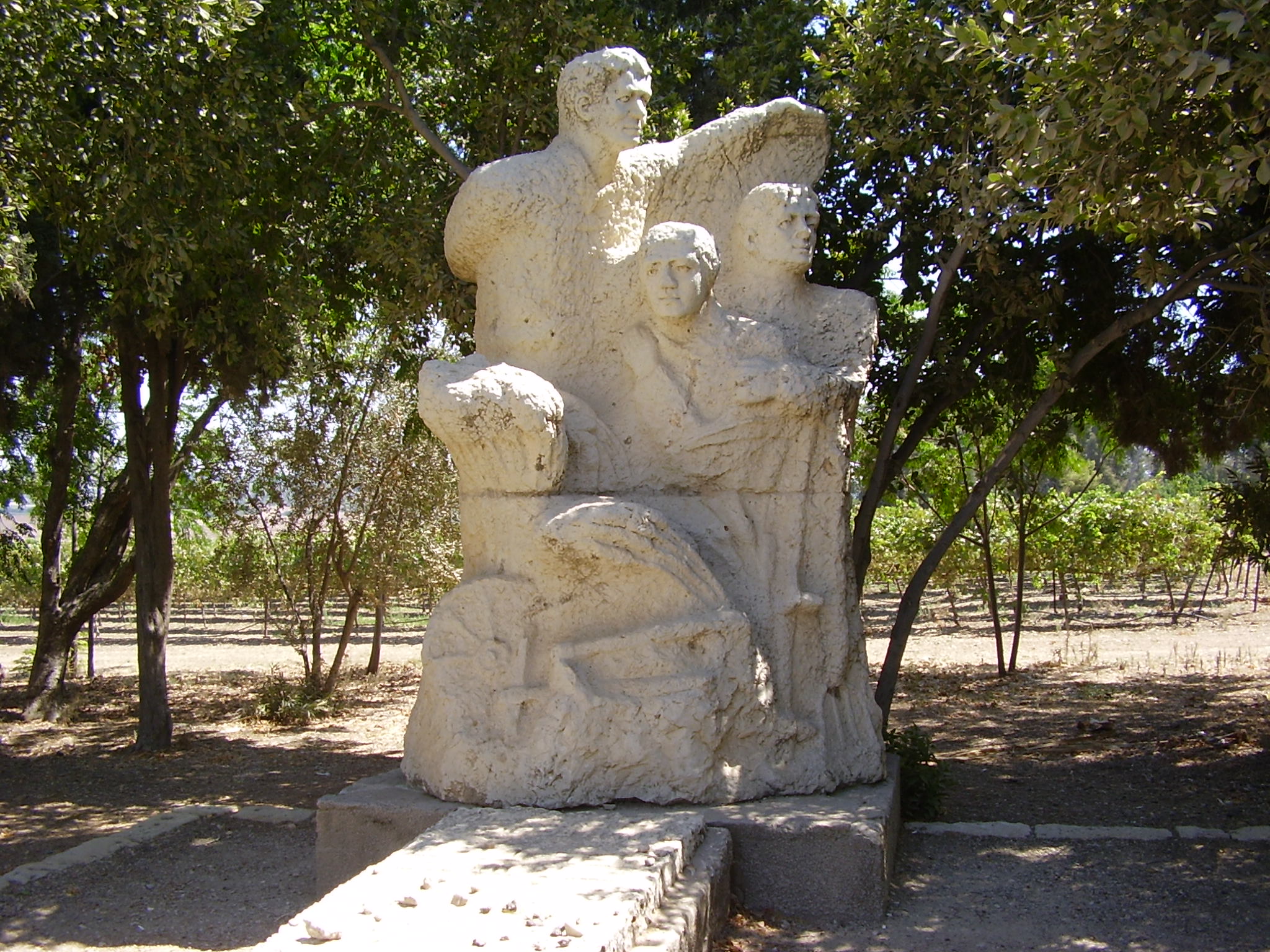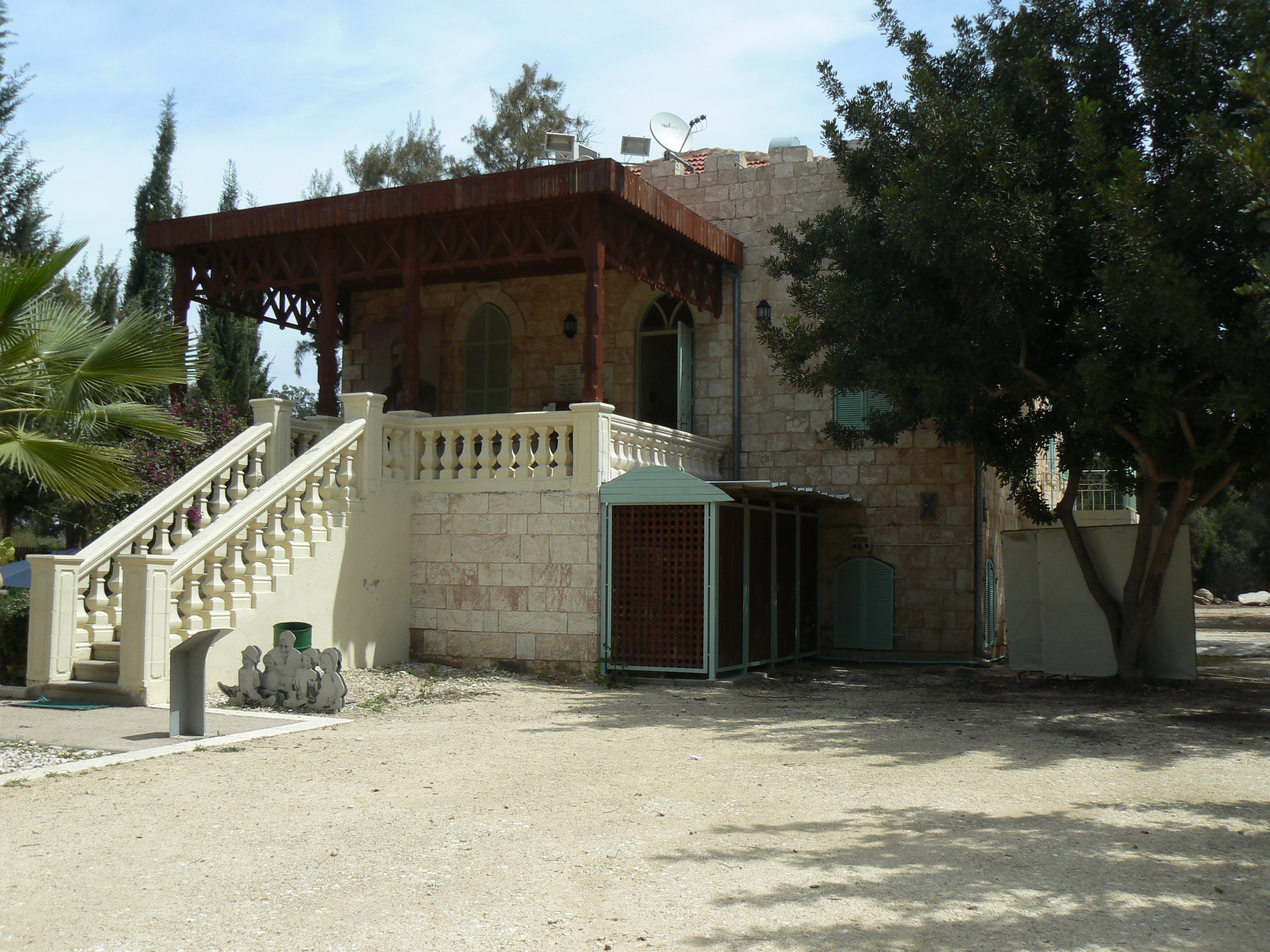Hulda, Israel on:
[Wikipedia]
[Google]
[Amazon]
Hulda () is a

/ref>
20
/ref> The farm suffered several more attacks during the

File:חולדה - בראשיתה.-JNF034917.jpeg, Hulda 1936
File:Harel in Hulda.jpg, Members of the Harel Brigade preparing to move from Hulda to Jerusalem in April 1948
File:Harel Nachshon.jpg, Members of the Harel Brigade assembling prior to Operation Nachshon in April 1948
File:Hulda 1905.jpg, Original 1905 building: a neglected ruin in 1948
President to President, Jerusalem Post
/ref>
 *
*
Official website
{{Authority control Kibbutzim Kibbutz Movement Populated places in Central District (Israel) 1929 Palestine riots
kibbutz
A kibbutz ( / , ; : kibbutzim / ) is an intentional community in Israel that was traditionally based on agriculture. The first kibbutz, established in 1910, was Degania Alef, Degania. Today, farming has been partly supplanted by other economi ...
in central Israel
Israel, officially the State of Israel, is a country in West Asia. It Borders of Israel, shares borders with Lebanon to the north, Syria to the north-east, Jordan to the east, Egypt to the south-west, and the Mediterranean Sea to the west. Isr ...
. Located in the Shephelah
The Shephelah () or Shfela (), or the Judaean Foothills (), is a transitional region of soft-sloping rolling hills in south-central Israel stretching over between the Judaean Mountains and the Coastal Plain. The different use of the term "Jud ...
near the Hulda Forest and the Burma Road
The Burma Road () was a road linking Burma (now known as Myanmar) with southwest China. Its terminals were Lashio, Burma, in the south and Kunming, China, the capital of Yunnan province in the north. It was built in 1937–1938 while Burm ...
, it falls under the jurisdiction of Gezer Regional Council. In it had a population of . The acclaimed Israeli writer, Amos Oz
Amos Oz (; born Amos Klausner (); 4 May 1939 – 28 December 2018) was an Israeli writer, novelist, journalist, and intellectual. He was also a professor of Hebrew literature at Ben-Gurion University of the Negev. From 1967 onwards, Oz was a pro ...
spent half his life living on the kibbutz.
Etymology
The kibbutz takes its name from thePalestinian
Palestinians () are an Arab ethnonational group native to the Levantine region of Palestine.
*: "Palestine was part of the first wave of conquest following Muhammad's death in 632 CE; Jerusalem fell to the Caliph Umar in 638. The indigenous p ...
village of Khulda, which existed nearby until the 1948 Arab–Israeli War
The 1948 Arab–Israeli War, also known as the First Arab–Israeli War, followed the 1947–1948 civil war in Mandatory Palestine, civil war in Mandatory Palestine as the second and final stage of the 1948 Palestine war. The civil war becam ...
.
History

Ottoman rule
In 1905, the Anglo Palestine Bank purchased of land from the Saidun tribe for a Jewish settlement near the Jaffa–Jerusalem railway. Ownership of the land was transferred to theJewish National Fund
The Jewish National Fund (JNF; , ''Keren Kayemet LeYisrael''; previously , ''Ha Fund HaLeumi'') is a non-profit organizationProfessor Alon Tal, The Mitrani Department of Desert Ecology, The Blaustein Institutes for Desert Research, Ben Gurion ...
which turned it over to the of the Zionist Organization (ZO). In 1909, the Hulda farm was established and a building (today Herzl House) was constructed to house the manager of the farm and was later used by the kibbutz members.Herzl never lived here/ref>
British Mandate
Groups of pioneers who trained at the Hulda farm helped establishEin Harod
Ein Harod () was a kibbutz in northern Israel near Mount Gilboa. Founded in 1921, it became the center of Mandatory Israel's kibbutz movement, hosting the headquarters of the largest kibbutz organisation, HaKibbutz HaMeuhad.
In 1923 part of the ...
(1921), Kfar Yehezkel
Kfar Yehezkel (, ''lit.'' Yehezkel Village) is a moshav in northern Israel. Located in the Jezreel Valley, six kilometres southeast of Afula, it falls under the jurisdiction of Gilboa Regional Council. In the moshav had a population of .
History ...
(1921), Ginegar (1922) and other kibbutz
A kibbutz ( / , ; : kibbutzim / ) is an intentional community in Israel that was traditionally based on agriculture. The first kibbutz, established in 1910, was Degania Alef, Degania. Today, farming has been partly supplanted by other economi ...
im. According to a census
A census (from Latin ''censere'', 'to assess') is the procedure of systematically acquiring, recording, and calculating population information about the members of a given Statistical population, population, usually displayed in the form of stati ...
conducted in 1922 by the British Mandate authorities, Hulda had a population of 40 Jews. During the 1929 Palestine riots
The 1929 Palestine riots, Buraq Uprising (, ) or the Events of 1929 (, , ''lit.'' Events of 5689 Anno Mundi), was a series of demonstrations and riots in late August 1929 in which a longstanding dispute between Palestinian Arabs and Jews ove ...
, the farm was attacked and destroyed. British forces ordered the evacuation of the settlers, but barred them from taking the body of Ephraim Chizik, the Haganah
Haganah ( , ) was the main Zionist political violence, Zionist paramilitary organization that operated for the Yishuv in the Mandatory Palestine, British Mandate for Palestine. It was founded in 1920 to defend the Yishuv's presence in the reg ...
commander who was killed in battle. In 1931, the Gordonia pioneer group resettled Hulda. The 1931 census mentions 49 inhabitants, with one residential house.Mills, 1932, p20
/ref> The farm suffered several more attacks during the
1936–1939 Arab revolt in Palestine
A popular uprising by Palestinian Arabs in Mandatory Palestine against the British administration, later known as the Great Revolt, the Great Palestinian Revolt, or the Palestinian Revolution, lasted from 1936 until 1939. The movement sought i ...
.There was however relative harmony between the pioneers and the Arab villagers of Khulda over the next seventeen years. The pioneers bought vegetable produce from the villagers and in turn provided them with medical supplies and medical treatment. Pioneers visited the village guesthouse and villagers were invited to the kibbutz communal dining hall. Both groups also shared a well.
On 31 March a convoy of the Harel Brigade left Hulda to deliver supplies to Jerusalem. The convoy was attacked by Arab forces from Ramla
Ramla (), also known as Ramle (, ), is a city in the Central District of Israel. Ramle is one of Israel's mixed cities, with significant numbers of both Jews and Arabs.
The city was founded in the early 8th century CE by the Umayyad caliph S ...
, killing twenty-two passengers.


1948 Arab–Israeli War
During the1948 Arab–Israeli War
The 1948 Arab–Israeli War, also known as the First Arab–Israeli War, followed the 1947–1948 civil war in Mandatory Palestine, civil war in Mandatory Palestine as the second and final stage of the 1948 Palestine war. The civil war becam ...
it served as the headquarters of the Palmach
The Palmach (Hebrew: , acronym for , ''Plugot Maḥatz'', "Strike Phalanges/Companies") was the elite combined strike forces and sayeret unit of the Haganah, the paramilitary organization of the Yishuv (Jewish community) during the period of th ...
's Yiftach Brigade
The 11th Brigade (also known as the Yiftach Brigade) is a reserves unit in the Israel Defense Forces, composed mainly of fighters that completed their compulsory service in the Egoz Unit, Unit 621 – 'Egoz'.
History
In the 1948 Arab–Israeli ...
and a base for convoys
A convoy is a group of vehicles, typically motor vehicles or ships, traveling together for mutual support and protection. Often, a convoy is organized with armed defensive support and can help maintain cohesion within a unit. It may also be used ...
bringing supplies to Jerusalem
Jerusalem is a city in the Southern Levant, on a plateau in the Judaean Mountains between the Mediterranean Sea, Mediterranean and the Dead Sea. It is one of the List of oldest continuously inhabited cities, oldest cities in the world, and ...
. After the first truce the Harel Brigade 4th Battalion, Company B, also had its headquarters at Hulda. The kibbutz became a staging ground for Jewish convoys trying to break the Arab siege on Jerusalem. 230 convoys were set out to transport supplies to the besieged city, the largest of which were organized near Kibbutz Hulda.
Since 1980
In the early 1980s, membership was about 220, but financial difficulties led to the exodus of many families, leaving only half that number. The kibbutz has since been privatized.Economy
The Hulda vineyard, covering over 1,200dunam
A dunam ( Ottoman Turkish, Arabic: ; ; ; ), also known as a donum or dunum and as the old, Turkish, or Ottoman stremma, was the Ottoman unit of area analogous in role (but not equal) to the Greek stremma or English acre, representing the amo ...
s, is the largest single vineyard in Israel. Hulda Transformers, established in 1975, produces and distributes transformers and power supplies for commercial, military and medical equipment. Yarok al Hamayim is a banquet facility at Kibbutz Hulda./ref>
Notable people
 *
* Ron Huldai
Ron Huldai (; born 26 August 1944) is an Israeli politician and businessman who has been Mayor of Tel Aviv since 1998. Before taking office as mayor, Huldai served as a fighter pilot and commander in the Israeli Air Force. After leaving the ...
, (whose father took the family surname from the name of the kibbutz)
* Pinhas Lavon
Pinhas Lavon (; 12 July 190424 January 1976) was an Israeli politician, minister and labor leader, best known for the Lavon Affair.
Early life
Lavon was born Pinhas Lubianiker in the small city of Kopychyntsi in the Galicia region of Austria ...
* Amos Oz
Amos Oz (; born Amos Klausner (); 4 May 1939 – 28 December 2018) was an Israeli writer, novelist, journalist, and intellectual. He was also a professor of Hebrew literature at Ben-Gurion University of the Negev. From 1967 onwards, Oz was a pro ...
, writer
References
External links
Official website
{{Authority control Kibbutzim Kibbutz Movement Populated places in Central District (Israel) 1929 Palestine riots